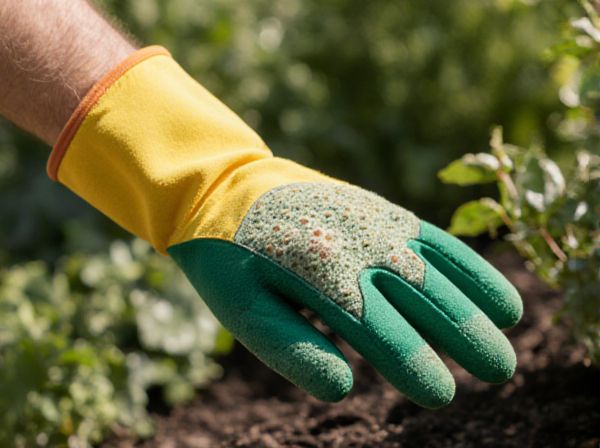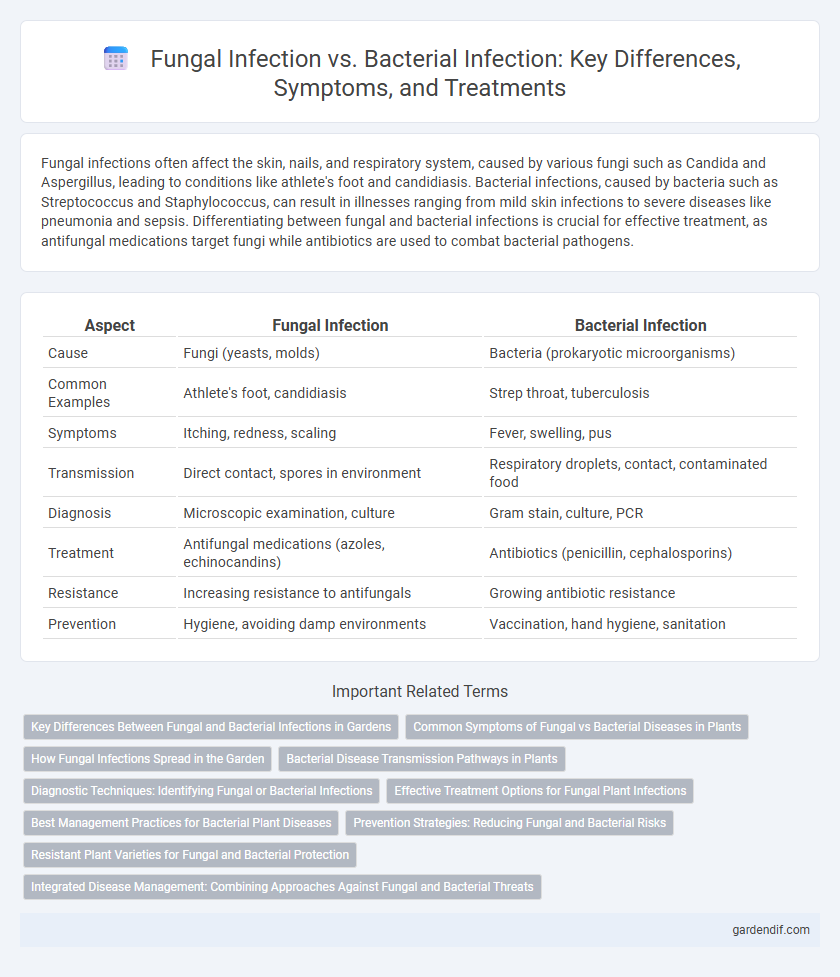
Fungal Infection vs Bacterial Infection Illustration
Fungal infections often affect the skin, nails, and respiratory system, caused by various fungi such as Candida and Aspergillus, leading to conditions like athlete's foot and candidiasis. Bacterial infections, caused by bacteria such as Streptococcus and Staphylococcus, can result in illnesses ranging from mild skin infections to severe diseases like pneumonia and sepsis. Differentiating between fungal and bacterial infections is crucial for effective treatment, as antifungal medications target fungi while antibiotics are used to combat bacterial pathogens.
Table of Comparison
| Aspect | Fungal Infection | Bacterial Infection |
|---|---|---|
| Cause | Fungi (yeasts, molds) | Bacteria (prokaryotic microorganisms) |
| Common Examples | Athlete's foot, candidiasis | Strep throat, tuberculosis |
| Symptoms | Itching, redness, scaling | Fever, swelling, pus |
| Transmission | Direct contact, spores in environment | Respiratory droplets, contact, contaminated food |
| Diagnosis | Microscopic examination, culture | Gram stain, culture, PCR |
| Treatment | Antifungal medications (azoles, echinocandins) | Antibiotics (penicillin, cephalosporins) |
| Resistance | Increasing resistance to antifungals | Growing antibiotic resistance |
| Prevention | Hygiene, avoiding damp environments | Vaccination, hand hygiene, sanitation |
Key Differences Between Fungal and Bacterial Infections in Gardens
Fungal infections in gardens typically manifest as powdery mildew, rust, or root rot, characterized by visible spores and mold growth on plants, whereas bacterial infections often cause wilting, leaf spots, and ooze from infected tissues. Fungi thrive in moist, humid conditions and spread through airborne spores, while bacteria proliferate in wet environments and enter plants through wounds or natural openings. Effective treatment for fungal infections includes fungicides and improving air circulation, while bacterial infections require copper-based bactericides and removal of infected plant parts to prevent spread.
Common Symptoms of Fungal vs Bacterial Diseases in Plants
Fungal infections in plants commonly cause symptoms such as powdery mildew, leaf spots, and wilting, often accompanied by visible fungal growth or spores. Bacterial infections typically result in water-soaked lesions, oozing, and soft rot, with yellow halos around affected areas and rapid tissue decay. Distinguishing fungal from bacterial symptoms is crucial for effective disease management and treatment selection in agriculture.
How Fungal Infections Spread in the Garden
Fungal infections in the garden spread primarily through spores carried by wind, water, insects, or contaminated tools, allowing pathogens to rapidly infect plants' leaves, stems, and roots. Unlike bacterial infections that often require direct contact or wounds for transmission, fungal spores can travel long distances and survive in soil or plant debris for extended periods. Understanding the mechanisms of fungal spore dispersal is crucial for implementing effective garden hygiene and disease prevention strategies.
Bacterial Disease Transmission Pathways in Plants
Bacterial disease transmission pathways in plants primarily include soilborne, waterborne, seedborne, and vector-mediated routes. Soilborne bacteria, such as Ralstonia solanacearum, infect plants through root wounds, while waterborne bacteria like Xanthomonas spp. spread via rain splash and irrigation. Insect vectors, including leafhoppers and aphids, facilitate bacterial entry by feeding on plant tissues, enhancing disease dissemination and severity.
Diagnostic Techniques: Identifying Fungal or Bacterial Infections
Diagnostic techniques for fungal infections often rely on microscopy, culture, and molecular assays such as PCR that detect specific fungal DNA sequences, enabling precise identification of species like Candida or Aspergillus. Bacterial infections are commonly diagnosed through Gram staining, culture on selective media, and rapid antigen detection tests, with molecular methods including 16S rRNA sequencing enhancing accuracy for pathogens like Staphylococcus aureus or Streptococcus pneumoniae. Serological assays and advanced imaging methods also support differential diagnosis by revealing immune responses or infection sites distinctive to fungal versus bacterial agents.
Effective Treatment Options for Fungal Plant Infections
Effective treatment options for fungal plant infections primarily include the application of systemic and contact fungicides such as azoxystrobin, chlorothalonil, and copper-based compounds, which inhibit fungal growth and spore germination. Cultural practices like crop rotation, proper irrigation, and sanitation reduce pathogen spread and enhance plant resistance against fungal pathogens. Biological control agents like Trichoderma spp. offer an eco-friendly alternative by antagonizing fungal pathogens and promoting plant health.
Best Management Practices for Bacterial Plant Diseases
Effective management of bacterial plant diseases involves crop rotation, use of resistant plant varieties, and proper sanitation to reduce pathogen spread. Application of copper-based bactericides and maintaining adequate plant spacing enhance disease control by minimizing moisture and bacterial proliferation. Early detection through regular monitoring allows timely intervention, preventing extensive crop damage and yield loss.
Prevention Strategies: Reducing Fungal and Bacterial Risks
Effective prevention strategies against fungal and bacterial infections emphasize maintaining proper hygiene, using antimicrobial soaps, and ensuring clean environments to minimize pathogen exposure. Wearing breathable clothing helps reduce fungal growth, while timely vaccination and appropriate antibiotic use control bacterial proliferation. Regular disinfection of frequently touched surfaces further lowers the risk of transmission for both infection types.
Resistant Plant Varieties for Fungal and Bacterial Protection
Resistant plant varieties play a crucial role in managing fungal infections by limiting pathogen spread through genetic traits that inhibit fungal growth and spore development. In bacterial disease control, resistant cultivars contain specific resistance genes that block bacterial entry and colonization, reducing the incidence of vascular wilts and leaf spots. Integrating resistant plant varieties with cultural practices significantly enhances crop resilience against both fungal and bacterial pathogens.
Integrated Disease Management: Combining Approaches Against Fungal and Bacterial Threats
Integrated disease management combines cultural practices, chemical treatments, and biological controls to effectively combat both fungal and bacterial infections in crops. Utilizing resistant plant varieties alongside targeted fungicides and bactericides reduces pathogen resistance and improves yield stability. Monitoring environmental conditions and pathogen presence enables timely interventions, enhancing disease suppression while minimizing chemical inputs.
Fungal Infection vs Bacterial Infection Infographic

 gardendif.com
gardendif.com